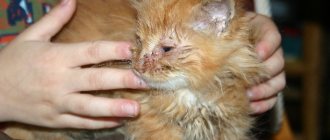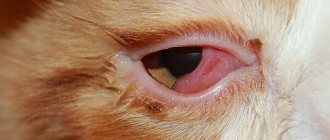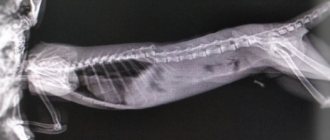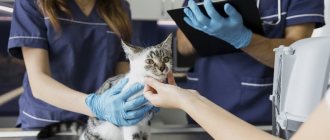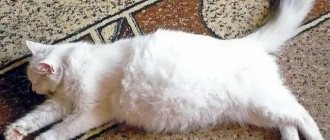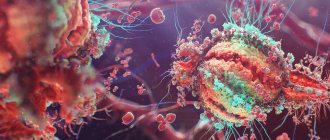The consultation is conducted by veterinarians - orthopedists. Performing the most complex orthopedic operations at the clinic. Postoperative hospital.
An injury such as a dislocation in a cat does not occur very often, and can sometimes go unnoticed by the owner for a long time. The fact is that representatives of most breeds have a “margin of strength” in their joints, and therefore, even with severe damage, everything is limited to sprains that go away without outside intervention.
At the same time, in large breed cats, dislocation of a limb or joint is a common injury. So the owners of such animals need to know how to identify a dislocation in a cat, what first aid measures should be taken immediately, and how to proceed further for the speedy recovery of the animal.
Causes of dislocations in cats
A dislocation is an injury that is accompanied by a violation of the integrity of the joint. The articular surfaces are displaced, and this may be accompanied by sprain or rupture of the ligaments, sometimes by damage to the joint capsule itself.
A dislocated joint in a cat can have a different nature. Acquired injuries resulting from trauma to the animal are quite common. The following can lead to dislocation:
- Falling from height.
- Damage caused by driving on slippery surfaces.
- Fights with other cats and larger animals.
- Limbs getting stuck in cracks and narrow openings.
- Strong impacts (for example, from a car accident).
- Jerking when handled carelessly (often found in kittens that small children play with).
The second group of injuries is congenital dislocations. A predisposition to such injuries develops at approximately 6 months of age due to dysplasia (improper formation) of the joints. The risk of dysplasia is determined not only by the conditions under which the animal is kept, but also by its breed. Maine Coons, Persians and Himalayan cats have a genetic predisposition to this type of damage.
The individual predisposition of the animal to joint damage should be highlighted as a separate group of reasons. It occurs against the background of pathologies affecting the integrity of bone and cartilage tissue. This type of dislocation occurs in cats suffering from osteoporosis or rickets.
Causes of injury
A restless cat can easily damage its paw, because one incorrectly calculated jump or failed maneuver can provoke a dislocation.
Even inappropriate play can injure a limb, so adults should be sure to explain to children the rules for handling animals, and before bringing a small kitten into the house.
Experts divide dislocations into 2 categories:
- Congenital.
- Acquired, that is, received due to injury.
Types of dislocations
Almost any joint in an animal’s body can suffer from injury. But still, some injuries are more common than others - it is their clinical picture that cat owners should study more carefully.
Dislocated paw in a cat
- A dislocated paw in a cat is the most common injury:
- Any of the joints of the fore or hind limb can be affected.
- With complete dislocation, the articular surfaces lose contact, and pathological mobility forms at the site of damage.
- With incomplete dislocation (subluxation), the surfaces may touch, but mobility is limited, swelling develops, and any movement causes pain and discomfort.
- Sometimes, when the animal moves, extraneous sounds occur in the joint area - grinding, clicking, etc.
- In the absence of complications, a dislocated shoulder joint in a cat can be reduced relatively easily. Proper treatment and compliance with rehabilitation recommendations allows you to fully preserve motor function.
Patella luxation
Patellar luxation in cats (dislocation of the kneecap or patella) is an injury that most often develops as a result of trauma.
Note! In dogs, the situation is the opposite - for them the main risk factor for patellar dislocation is a genetic predisposition, which is expressed in poor development of the ligamentous apparatus or defects in the development of the condyles.
For a dislocated kneecap:
- The patella slips off the condyles, shifting on the ligaments.
- With a weak development of the pathology, the kneecap can spontaneously return to its place, causing minimal discomfort.
- Stage 3-4 of development of patellar dislocation is accompanied by periodic displacement of the patella under minor impacts. In addition, after reduction, the patella is weakly held on the condyles, “flying out” at the slightest load on the limb.
The situation here is more complicated than with an ordinary dislocation of a joint in a cat. The main problem is the inability to give an accurate forecast of recovery, especially at stages 3-4 of development. Without surgical intervention, the likelihood of relapses is high, and in advanced situations, even surgical treatment of patellar dislocation does not guarantee the absence of recurrent injuries.
Hip dislocation in a cat
Like other dislocations, hip dislocation can occur under strong mechanical stress. The likelihood of such damage increases with dysplasia or bursitis, as well as osteoporosis and arthritis in the animal.
For dislocation of the hip joint in cats:
- The head of the tibia emerges from the socket.
- The joint capsule is damaged.
- The load on the ligaments that support bones and muscles increases.
- Often there is a tear of the ligaments, sometimes muscles.
The symptoms of such a dislocation in a cat are quite obvious. The hind limb is at an incorrect angle, and can practically rotate on the joint (i.e., its mobility is almost unlimited). The animal experiences severe pain even when it does not rely on the limb, and severe swelling forms at the site of the dislocation.
Note! Significant pain with such a dislocation complicates the examination and diagnosis of damage. For this reason, veterinarians can use local anesthesia or even general anesthesia at the preliminary stage.
Dislocation of the lower jaw
The lower jaw can be injured when:
- Strong blows.
- Falls.
- Eating food.
As a rule, in cats, bilateral dislocation of the jaw occurs, which can be complicated by a fracture of the processes that form the joint.
Typical symptoms:
- Mouth not closing.
- The lower jaw protrudes forward and may move slightly to one side.
- Profuse salivation.
- Tongue prolapse.
Protruding eyes may also occur due to the displacement of the jawbone. The injury is also accompanied by swelling and increased pain.
Note! During the initial diagnosis and provision of first aid to the animal owner, it is important to separate the dislocation of the lower jaw from paralysis of the maxillofacial muscles (one of the symptoms of rabies) and from objects getting stuck in the mouth that interfere with normal jaw movement. In the first case, the animal's mouth remains open, but closes easily with little effort without resistance. In the second, the position of the lower jaw does not change, but its movement is blocked by a foreign object.
In case of damage to the lower jaw, not complicated by fractures, reduction of dislocations in cats can be performed independently. To do this, the coronoid process is pulled back and down, after which the jaw falls into place with almost no effort on the part of the owner. However, this technique should be used only if there is no opportunity to receive qualified medical care in the near future.
Main symptoms
In case of fractures and dislocations, the animal exhibits general clinical signs: pain, impaired motor function (lameness), swelling of the damaged area.
There are three types of fractures: closed, open, and displaced. Serious damage also includes cracks.
Signs of an open fracture in a cat:
- violation of the integrity of the skin;
- the bone is broken, its ends are displaced and protrude;
- tissue rupture in the fracture area;
- bleeding;
- strong pain.
With open wounds, the risks of tissue necrosis and infection are very high.
A closed fracture without displacement is characterized by the following symptoms: the broken bone is in its usual position, the skin and tissues swell, turn blue, and turn red. In a displaced fracture, the bone diverges in different directions, and the soft tissue is partially damaged. There is a danger of internal bleeding.
A crack can easily be confused with a bruise. The bone remains intact, its edges do not diverge and are held in place by the undamaged area. The cat may move carefully, but it may be in pain.
A simple dislocation is recognized by the following signs:
- skin and tissue remain intact;
- lameness;
- inability to lean on the surface;
- pain when touching the injured limb;
- The dislocated part of the body is asymmetrical.
A complex dislocation, accompanied by rupture of ligaments and tendons, is characterized by the appearance of hematomas in the injured area.
Tail damage
Despite the significant mobility of the organ, the tail can also suffer from dislocations. Typical situations that can lead to this injury:
- The child may pull the tail.
- An adult can step on the tail.
- The tail may get caught in the gap between the jamb and the door leaf when closing it.
In all these situations, either a dislocation or a twist in the tail can be observed. Only a veterinarian can accurately diagnose an injury, but it is usually accompanied by a curvature of the tail in a local area and swelling at the site of injury. Also, due to the displacement of the caudal vertebrae, the mobility of the tail is limited.
Damage to a claw on a paw
Even though cat's claws are naturally tough and resistant, they are not immune to possible troubles. However, some incidents are not so serious, especially since the claws can grow back quickly.
The claw can be injured during a fight, especially during the period of estrus in females, or, for example, during a traffic accident. At this time, you should make sure that the cat has not lost one or more claws. In this case, bleeding is observed because this area is heavily vascularized.
Therefore, it is important to take your cat to a veterinarian for possible disinfection of the wound to avoid any risk of infection, and to administer adequate treatment to alleviate the animal's condition and speed up healing.
However, if the claw is indeed still implanted in its place, but is broken at the level of the keratinized and unvascularized white part, it is sufficient to simply cut it off with a claw knife designed specifically for cats. It is not recommended to use wire cutters. If the lesion is painful, it is best to contact your veterinarian.
Dislocation in a cat: what to do?
Only a specialist in a veterinary clinic can professionally treat a dislocation in a cat. But the task of the animal owner is to identify the injury in time and provide first aid to the animal.
The optimal algorithm of actions will be as follows:
- Diagnose the damage by determining its location (which joint is affected) and its nature. Here it is important to understand whether a dislocation has occurred, or whether there is a sprain in the joint or a fracture.
- Assess the severity of the situation (subluxation, simple dislocation, or damage complicated by tearing of ligaments/muscles or bone fragments entering the joint capsule).
- Limit the animal’s mobility – first of all, to prevent the cat from aggravating the injury.
- If possible, reduce the intensity of pain. If the animal feels severe discomfort in the area of injury, pain relievers (Nalbuphine, Ketofen) can be used. Applying ice packs to the site of dislocation is only allowed for a short period of time, since hypothermia can significantly complicate the doctor’s task of reducing the injury.
- Immobilize the injured area with a bandage, if possible and if the cat's activity allows this to be done without the risk of aggravating the injury. If the cat is actively struggling, place it in a carrying basket or cardboard box with a minimum of free space.
Important! If you provide first aid to a stray animal, then take safety measures to avoid scratches and bites. Remember that cats can carry rabies and other dangerous diseases.
After first aid has been provided, the animal should be taken to a veterinary clinic to provide qualified medical care.
When providing first aid and transporting an animal to a medical facility, the priority is to minimize the time between injury and reduction of the dislocation. The sooner the integrity of the joint is restored, the easier the operation will be, and the faster the cat’s rehabilitation after injury will be.
When delaying time:
- Muscle contracture forms.
- A blood clot will form in the joint capsule.
- Scar tissue will begin to form, which will fix the articular surfaces in the wrong position.
All this will lead to the fact that instead of a quick closed reduction, a complex, time-consuming operation will be required. In addition, prolonged failure to provide assistance for a dislocation in a cat can lead to destruction of the articular surfaces. The result will be the impossibility of providing medical care even in a hospital setting, and the joint will have to be removed (this will lead to serious consequences and severe limitation of mobility).
Pain relief for cats
Most injuries cause the cat to experience severe pain. The owner can independently reduce it by using pain relief therapy. Special veterinary drugs ketofen or nalbuphine are well suited for this purpose. But it is better not to give such popular painkillers as baralagin and analgin, especially in tablet form, to a cat, because they cause severe salivation in the animal. As a last resort, you can inject analgin by injecting 0.4 ml intramuscularly (dose for an average cat).
Also, in case of injury, traumatic shock is possible, one of the manifestations of which is vasospasm. This spasm has a very bad effect on the liver and kidneys. It can be removed with anti-shock therapy. The affected animal should be given corticosteroid drugs, for example, prednisolone (0.3-0.5 ml intramuscularly). But injections should only be considered as an emergency aid. At the veterinary clinic, anti-shock therapy will be continued using drip infusion.
Let's remember about rabies. Cats get rabies in the same way as dogs, so they also need to be vaccinated. It is very important that owners do not forget about this. Rabies can be transmitted to an unvaccinated cat even through a minor bite, and the owner or staff of the veterinary clinic can become infected from it. That is why, when going to the doctor, do not forget to take the animal’s veterinary passport with you. If a cat does not have a rabies vaccination, then the veterinary clinic may refuse to accept it, especially if the animal has a biting laceration received from an unknown location. The safety of people comes before the desire to save the injured animal. Moreover, many cases of rabies are registered in the Moscow region.
Diagnosis and treatment of dislocations
Treatment of dislocation in cats in a veterinary clinic begins with diagnosis. It includes:
- Examine the animal for signs of injury.
- Palpation of the damaged area for precise localization of the articular surfaces.
- X-ray examination.
- If there is a suspicion of a complication of the injury by ligament rupture, disruption of the integrity of the joint capsule, or damage to the bone processes, an MRI of the joint is performed.
Since the animal's mobility or pain may make an accurate diagnosis difficult, during the examination the veterinarian will decide whether anesthesia or general anesthesia is appropriate.
The answer to the question “How to treat a dislocation in a cat?” depends primarily on the nature and severity of the damage:
In some cases, closed reduction of the dislocation can be performed. The veterinarian puts the joint elements back into place with force, restoring the shape of the joint, after which the limb is fixed. With the exception of some situations (mild subluxations, habitual dislocation of the lower jaw), manipulations are performed under general anesthesia with the muscles as relaxed as possible - this makes it possible to minimize pain and avoid injuries.
If closed reduction is not possible, surgery is performed. The veterinary surgeon’s further actions depend on how complex the dislocation is and what reduction method is considered correct in this particular case.
For immobilization, splints or elastic bandages are used. Complicated dislocations sometimes require immobilization using screws, plates or surgical wires - for example, this is how a dislocated hip joint or a dislocated hip in a cat is reduced. There is no need to fix damaged areas only in case of mild subluxation or other mild injury.
First aid
Experts categorically prohibit adjusting a dislocation on your own at home, but it is mandatory to help your pet at the first obvious symptoms:
- First of all, you should try to neutralize the damaged paw by fixing it with a bandage and a small ruler.
- The pet should be placed comfortably in a special transportation device to limit its movement.
- The damaged area should not be kneaded under any circumstances, but a cold compress applied for 30 minutes will come in handy.
You should not try to feed or water the animal, as when visiting the clinic, the doctor will most likely administer anesthesia to painlessly set the displaced bone.
Animal rehabilitation
The prognosis for recovery and the timing of a cat’s complete recovery after a dislocation depend on the following factors:
- Damaged joint.
- Severity of injury.
- Efficiency and quality of first aid.
- Time to reduce the dislocation.
- Nature of therapy (closed or surgical reduction, fixation with a bandage or knitting needles).
As a rule, in each case, the veterinarian gives individual recommendations on the timing of rehabilitation and how to support the animal during the recovery period.
The general scheme for caring for a cat after treatment for a dislocated limb will be as follows:
- Immediately after the operation, the cat can remain under the supervision of a veterinarian in the hospital for about a day. If the owner takes the animal home, then it is important to follow the recommendations for a comfortable recovery from general anesthesia - lack of anxiety, limitation of movements (especially jumping), free access to water. You can feed your cat no earlier than 12 hours after surgery.
- If necessary, in the first 3-5 days of the rehabilitation period, the animal can be prescribed painkillers and antibiotics, as well as agents that relieve swelling and inflammation.
- To speed up recovery, you can perform massage (the technique of massaging the damaged joint is simple and can be explained by a veterinarian). This improves blood circulation in damaged tissues and the joint returns to normal faster.
- In order not to aggravate the injury, it is advisable to eliminate the load on the damaged joint. To do this, the cat’s movement around the house is limited, trying to leave it in a room without high objects: jumping is contraindicated for the animal. Forced restriction of movement (for example, in a cage) is advisable only in the first 1-2 days after surgery: in the future, the cat itself controls the situation and doses the load.
- If reduction of the dislocation required surgical intervention, then the postoperative wound must be treated to avoid infection. After dense scar tissue has formed, the sutures are removed at the veterinary clinic. Important! The condition of the seam must be monitored, excluding its gnawing and “licking”. To prevent this, the seam is treated with drugs with a strong odor or a collar is placed on the animal.
- When fixing the jaw (it is required in case of complicated dislocation), it is necessary to provide the animal with full force-feeding of liquid nutritional mixtures.
On average, the time for complete restoration of mobility ranges from 3-4 weeks in young and adult animals to 5-6 weeks in older cats.
Operation for advanced cases
Surgery is necessary for advanced or complex dislocations.
After receiving an injury, the dislocation must be corrected as soon as possible. Delay in receiving medical help leads to muscle contraction, the formation of a dense blood clot and scar tissue. These changes make it difficult to reduce the dislocation using a closed method. In such cases, the question arises about surgical treatment of advanced dislocations.
During the operation, during which the animal is asleep, an incision is made in the joint area, through which fibrin clots and destroyed parts of the joint are removed. The joint returns to its original position; this will require force or special levers. A joint reduced openly also requires fixation and temporary immobilization.
Sometimes a cat requires surgical fixation of a joint:
- for dislocations of the hip or wrist joints, it is carried out using special pins;
- for elbow and ankle - screws and wires.
Congenital dislocations in furry pets are usually eliminated using the open method. After a minor dislocation, the animal recovers within 3-4 days. The cat can use its paw, but has a slight limp. Full recovery from severe dislocations takes about 3-4 weeks.
Diagnosis of the problem in the clinic
When examining a furry patient, a veterinarian will ask about the nature of the injury and palpate the damaged joint. The most reliable way to diagnose injuries to the musculoskeletal system is x-ray examination.
X-ray of left hip dislocation
This method allows not only to detect pathology, but also to determine the direction of dislocation, establish the condition of the ligamentous apparatus, and assess the degree of destruction of the joint and periarticular tissues.
Reduction of dislocation in hospital
Treatment for a joint injury should be carried out as quickly as possible. Immediate assistance consists of closed reduction of the dislocation, which is carried out with subsequent x-ray monitoring. The procedure usually requires general anesthesia for the animal, as it is very painful. Often during manipulation, muscle relaxants are used - muscle relaxing medications.
In order to ensure the success of the procedure, the reduced limb is bent and unbent, and rotational movements are performed with the paw (moved inward and to the side).
After reduction, the damaged joint is fixed with special bandages to prevent relapse, which the animal wears for 10 to 14 days.
Reduction of a dislocated jaw in cats
A dislocated jaw is corrected by placing a stick across the mouth. A successful manipulation is characterized by a click of the articular head of the jaw. After adjustment, the cat is prescribed a gentle diet of wet food.
If a pathology of the hip joint is detected in a pet, veterinary specialists use surgical needles. For dislocations of the upper and lower extremities, wires and screws are used.
After the assistance, the animal is prescribed complete rest, a balanced diet, and vitamin therapy. On the recommendation of a doctor, anti-inflammatory, painkillers, chondroprotectors and immunomodulators can be prescribed.
We recommend reading about a cat's tail fracture. You will learn about the causes of these fractures, signs and symptoms of injuries, diagnosis and treatment with casting and tail amputation. And here is more information about what to do if a cat is lame on its paw.



